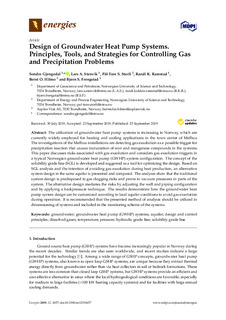| dc.contributor.author | Gjengedal, Sondre | |
| dc.contributor.author | Stenvik, Lars Aaberg | |
| dc.contributor.author | Storli, Pål-Tore Selbo | |
| dc.contributor.author | Ramstad, Randi Kalskin | |
| dc.contributor.author | Hilmo, Bernt Olav | |
| dc.contributor.author | Frengstad, Bjørn S. | |
| dc.date.accessioned | 2019-09-25T16:53:12Z | |
| dc.date.available | 2019-09-25T16:53:12Z | |
| dc.date.created | 2019-09-25T13:17:35Z | |
| dc.date.issued | 2019 | |
| dc.identifier.citation | Energies. 2019, 12 . | nb_NO |
| dc.identifier.issn | 1996-1073 | |
| dc.identifier.uri | http://hdl.handle.net/11250/2618832 | |
| dc.description.abstract | The utilization of groundwater heat pump systems is increasing in Norway, which are currently widely employed for heating and cooling applications in the town center of Melhus. The investigations of the Melhus installations are detecting gas exsolution as a possible trigger for precipitation reaction that causes incrustation of iron and manganese compounds in the systems. This paper discusses risks associated with gas exsolution and considers gas exsolution triggers in a typical Norwegian groundwater heat pump (GWHP) system configuration. The concept of the solubility grade line (SGL) is developed and suggested as a tool for optimizing the design. Based on SGL analysis and the intention of avoiding gas exsolution during heat production, an alternative system design in the same aquifer is presented and compared. The analyses show that the traditional system design is predisposed to gas clogging risks and prone to vacuum pressures in parts of the system. The alternative design mediates the risks by adjusting the well and piping configuration and by applying a backpressure technique. The results demonstrate how the groundwater heat pump system design can be customized according to local aquifer conditions to avoid gas exsolution during operation. It is recommended that the presented method of analysis should be utilized in dimensioning of systems and included in the monitoring scheme of the systems. | nb_NO |
| dc.language.iso | eng | nb_NO |
| dc.publisher | MDPI | nb_NO |
| dc.rights | Navngivelse 4.0 Internasjonal | * |
| dc.rights.uri | http://creativecommons.org/licenses/by/4.0/deed.no | * |
| dc.title | Design of Groundwater Heat Pump Systems. Principles, Tools, and Strategies for Controlling Gas and Precipitation Problems | nb_NO |
| dc.type | Journal article | nb_NO |
| dc.type | Peer reviewed | nb_NO |
| dc.description.version | publishedVersion | nb_NO |
| dc.source.pagenumber | 20 | nb_NO |
| dc.source.volume | 12 | nb_NO |
| dc.source.journal | Energies | nb_NO |
| dc.identifier.doi | 10.3390/en12193657 | |
| dc.identifier.cristin | 1728887 | |
| dc.description.localcode | © 2019 by the authors. Licensee MDPI, Basel, Switzerland. This article is an open access article distributed under the terms and conditions of the Creative Commons Attribution (CC BY) license (http://creativecommons.org/licenses/by/4.0/). | nb_NO |
| cristin.unitcode | 194,64,90,0 | |
| cristin.unitcode | 194,64,25,0 | |
| cristin.unitname | Institutt for geovitenskap og petroleum | |
| cristin.unitname | Institutt for energi- og prosessteknikk | |
| cristin.ispublished | true | |
| cristin.fulltext | original | |
| cristin.qualitycode | 1 | |

